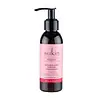What's inside
What's inside
 Key Ingredients
Key Ingredients

 Benefits
Benefits

 Concerns
Concerns

 Ingredients Side-by-side
Ingredients Side-by-side

Water
Skin ConditioningAloe Barbadensis Leaf Juice
Skin ConditioningSesamum Indicum Seed Oil
EmollientCetearyl Alcohol
EmollientGlycerin
HumectantCetyl Alcohol
EmollientCeteareth-20
CleansingRosa Canina Fruit Oil
EmollientOenothera Biennis Oil
EmollientSantalum Acuminatum Fruit Extract
AntioxidantBorago Officinalis Seed Oil
EmollientCamellia Oleifera Seed Oil
Skin ConditioningButyrospermum Parkii Butter
Skin ConditioningTocopherol
AntioxidantLavandula Angustifolia Oil
MaskingCitrus Nobilis Peel Oil
MaskingCitrus Tangerina Peel Oil
MaskingVanillin
MaskingPhenoxyethanol
PreservativeBenzyl Alcohol
PerfumingLimonene
PerfumingLinalool
PerfumingWater, Aloe Barbadensis Leaf Juice, Sesamum Indicum Seed Oil, Cetearyl Alcohol, Glycerin, Cetyl Alcohol, Ceteareth-20, Rosa Canina Fruit Oil, Oenothera Biennis Oil, Santalum Acuminatum Fruit Extract, Borago Officinalis Seed Oil, Camellia Oleifera Seed Oil, Butyrospermum Parkii Butter, Tocopherol, Lavandula Angustifolia Oil, Citrus Nobilis Peel Oil, Citrus Tangerina Peel Oil, Vanillin, Phenoxyethanol, Benzyl Alcohol, Limonene, Linalool
Water
Skin ConditioningSodium Cocoamphoacetate
CleansingGlycerin
HumectantLauryl Glucoside
CleansingSodium Cocoyl Glutamate
CleansingSodium Lauryl Glucose Carboxylate
CleansingCocamidopropyl Betaine
CleansingGlyceryl Laurate
EmollientLactobacillus Ferment
Skin ConditioningLactobacillus/Portulaca Oleracea Ferment Extract
AntioxidantSaccharomyces Ferment
Skin ConditioningPentylene Glycol
Skin ConditioningGlyceryl Oleate
EmollientCoco-Glucoside
CleansingGluconolactone
Skin ConditioningSodium Benzoate
MaskingOryza Sativa Extract
AbsorbentPanthenol
Skin ConditioningXanthan Gum
EmulsifyingCopper Tripeptide-1
Skin ConditioningCitric Acid
BufferingWater, Sodium Cocoamphoacetate, Glycerin, Lauryl Glucoside, Sodium Cocoyl Glutamate, Sodium Lauryl Glucose Carboxylate, Cocamidopropyl Betaine, Glyceryl Laurate, Lactobacillus Ferment, Lactobacillus/Portulaca Oleracea Ferment Extract, Saccharomyces Ferment, Pentylene Glycol, Glyceryl Oleate, Coco-Glucoside, Gluconolactone, Sodium Benzoate, Oryza Sativa Extract, Panthenol, Xanthan Gum, Copper Tripeptide-1, Citric Acid
 Reviews
Reviews

Ingredients Explained
These ingredients are found in both products.
Ingredients higher up in an ingredient list are typically present in a larger amount.
Glycerin is already naturally found in your skin. It helps moisturize and protect your skin.
A study from 2016 found glycerin to be more effective as a humectant than AHAs and hyaluronic acid.
As a humectant, it helps the skin stay hydrated by pulling moisture to your skin. The low molecular weight of glycerin allows it to pull moisture into the deeper layers of your skin.
Hydrated skin improves your skin barrier; Your skin barrier helps protect against irritants and bacteria.
Glycerin has also been found to have antimicrobial and antiviral properties. Due to these properties, glycerin is often used in wound and burn treatments.
In cosmetics, glycerin is usually derived from plants such as soybean or palm. However, it can also be sourced from animals, such as tallow or animal fat.
This ingredient is organic, colorless, odorless, and non-toxic.
Glycerin is the name for this ingredient in American English. British English uses Glycerol/Glycerine.
Learn more about GlycerinWater. It's the most common cosmetic ingredient of all. You'll usually see it at the top of ingredient lists, meaning that it makes up the largest part of the product.
So why is it so popular? Water most often acts as a solvent - this means that it helps dissolve other ingredients into the formulation.
You'll also recognize water as that liquid we all need to stay alive. If you see this, drink a glass of water. Stay hydrated!
Learn more about Water